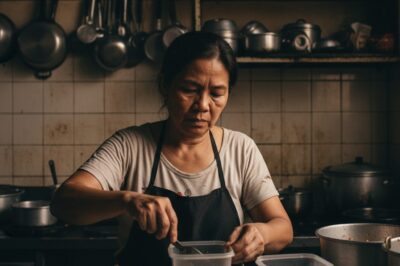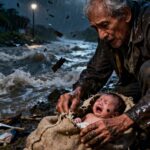On the flight from Bangkok to Manila, I chose a window seat, hoping to enjoy some peace and quiet before landing. As soon as the plane took off, I opened my book to read, but not long after, a woman walked quickly over, her arms full of a large tote bag, her mouth laughing loudly. She plopped down in the seat next to me, not even bothering to ask permission or look at me.
I glanced over. She was wearing a colorful floral shirt, her hair tied up high, and wearing large sunglasses even though we were in the cabin. She started chatting with her friend sitting in the row in front of her, her voice loud enough for the whole row to hear:
“Uy bes, naaalala mo yung lalaki kahapon sa palengke? Akala niya madali akong mauto!” Then she burst out laughing, the kind of laughter that startled me and almost made me drop my book.
I tried to concentrate, but it was hard when she kept taking up my space. She reached for water, spilling a cup of coffee on the small table.
– “Ay naku, sorry ha!” – she said, her voice as calm as if nothing had happened. I nodded, quickly wiped the coffee stain on my pants, thinking: “There are only about two more hours, bear with it.”
What annoyed me more was that she was not sitting in the right seat. Her seat – I overheard from the conversation with my friend – was in row 15, a few rows away. But she still brazenly sat in row 12 next to me to be closer to my friend. When the flight attendant checked the ticket, she smiled brightly:
– “Eh di ba pareho lang, saan man umupo?”
The flight attendant was still polite, but I saw her shake her head slightly as she turned away.
She told stories nonstop: from buying a fake bag at Chatuchak market to arguing with a tuktuk driver. Each story ended with a burst of laughter. At one point she turned to me:
– “Kuya, bakit ka pumunta sa Bangkok? Shopping o bakasyon?”
I answered briefly: “Business.” She nodded, then turned away immediately.
But then I caught a glimpse of something strange. When she rummaged through her bag for her phone, a small photo fell out – of a child about four or five years old, smiling brightly. She quickly stuffed it into her purse, but I caught a glimpse of sadness in her eyes.
In the middle of the flight, she suddenly fell silent. I was secretly happy, but she turned to ask, her voice much softer:
– “Kuya, siguro naiinis ka na sa akin, ano?”
I was surprised. She smiled awkwardly:
– “Alam kong maingay ako… pero kasi, pag tahimik, hindi ko kaya.”
I asked: “Bakit naman?”
She sighed, her eyes looking out the window at the white clouds:
– “Kaka-uwi ko lang galing Bangkok… hinanap ko sana yung kamag-anak ng anak ko. Siya namatay last year… aksidente. Gusto ko lang may makausap tungkol sa kanya, para hindi siya makalimutan. Pero wala akong natagpuan.”
Her voice choked up. “Kaya ako tawa, daldal, para hindi ko maalala. Kasi pag tahimik… doon siya bumabalik.”
I was speechless. All her noise, jostling, and laughter turned out to be just a cover. She was not rude, but just struggling to survive the pain, in the most clumsy way.
When the plane landed at NAIA Terminal 3, she picked up her bag, stood up, and turned to me:
– “Salamat ha, hindi mo ako pinagalitan.”
I laughed and replied, “Walang problema.”
She pulled her friend’s hand away, and the laughter rang out again. But this time, in my heart, it was no longer noise… but the sound of a mother trying to hold on to the memories of her child.
It turns out that behind the things that make us upset, there is sometimes a story that we have never understood.
As the plane was about to land at NAIA Terminal 3, the “ding” sound of fastening the seat belt rang out. I was closing the book when the woman suddenly turned around, her eyes suddenly different – no longer noisy, no longer joking.
She rummaged in her bag, took out a small photo, and handed it to me.
“Kuya… ito anak ko.”
I took it. In the photo was a boy about five years old, his smile as bright as the sun. His eyes were sparkling, his hair was messy. My heart clenched slightly. The woman continued, her voice trembling:
“Last year… aksidente. Wala na siya. Kaya ako pumunta Bangkok, gusto ko hanapin kahit isang kamag-anak, para may magkuwento tungkol sa kanya. Pero wala akong nakita.”
She paused, tears rolling down but her mouth still forced a smile.
– “Ngayon… kahit isang tao lang sa eroplano nay, makakita sa mukha ng anak ko, alam na siya ay totoo, na minsan siyang nabuhay… sapat na sa akin.”
I was stunned, my hand still holding the photo of the little boy. All the noise, jostling, and laughter at first suddenly disappeared, replaced by a deep sadness. I looked at her, nodded slightly:
– “Oo, nakita ko. At hinding-hindi ko makakalimutan.”
The plane touched down on the runway, its body shaking violently. The woman quickly wiped her tears, put the photo in her shirt, then pulled up her large bag and stood up. But before leaving, she looked at me one more time, smiling warmly – not a forced or noisy smile, but a genuine, relieved smile.
I sat still, watching her back disappear into the crowd. In my heart, I silently reminded myself: “It turns out, sometimes the most precious thing we can do for a stranger… is just to listen and remember.”
News
Pinagtawanan ang Babaeng Tagahugas ng Plato Dahil sa Pagtatabi ng Tirang Pagkain — Hanggang Isiniwalat ng Nakatagong Kamera ang Katotohanan/hi
Pinagtawanan ang Babaeng Tagahugas ng Plato Dahil sa Pagtatabi ng Tirang Pagkain — Hanggang Isiniwalat ng Nakatagong Kamera ang KatotohananHuling…
ISANG MAHIRAP NA MAG-ASAWA NA HINDI MAGKAANAK, NAKATAGPO NG TATLONG SANGGOL SA NIYEBE — DALAWANG DEKADA ANG LUMIPAS, AT IPINAKITA NG MUNDO KUNG ANO ANG TUNAY NA PAMILYA…/HI
ISANG MAHIRAP NA MAG-ASAWA NA HINDI MAGKAANAK, NAKATAGPO NG TATLONG SANGGOL SA NIYEBE — DALAWANG DEKADA ANG LUMIPAS, AT IPINAKITA…
PINULOT NG JEEPNEY DRIVER ANG SANGGOL NA INIWAN SA KANYANG PASADA, AT NAPALUHA SIYA NANG ITO MISMO ANG DOKTOR NA NAGSALBA SA KANYA PAGKALIPAS NG 23 TAON/hi
PINULOT NG JEEPNEY DRIVER ANG SANGGOL NA INIWAN SA KANYANG PASADA,AT NAPALUHA SIYA NANG ITO MISMO ANG DOKTOR NA NAGSALBA…
HINAGISAN NG CUSTOMER NG PAGKAIN ANG RIDER DAHIL “LATE” DAW, PERO NALAGLAG ANG PANGA NIYA NANG TANGGALIN NITO ANG HELMET/hi
HINAGISAN NG CUSTOMER NG PAGKAIN ANG RIDER DAHIL “LATE” DAW, PERO NALAGLAG ANG PANGA NIYA NANG TANGGALIN NITO ANG HELMETBumabagyo…
NATAKOT ANG STEP-DAD NANG IPATAWAG SIYA SA PRINCIPAL’S OFFICE, PERO NABASA NG LUHA ANG MATA NIYA NANG IPAKITA NG GURO ANG DRAWING NG BATA/hi
NATAKOT ANG STEP-DAD NANG IPATAWAG SIYA SA PRINCIPAL’S OFFICE, PERO NABASA NG LUHA ANG MATA NIYA NANG IPAKITA NG GURO…
Sa kabila ng karamdaman ng kanyang asawa sa ospital at ng mga batang nangangailangan, isinama siya ng asawa sa isang paglalakbay sa Europa para sa Pasko. Ang biyenan ko ay nagpunta sa lungsod, nakita ang katotohanan, at gumawa ng isang malaking bagay sa kanyang sarili na nagpahirap sa buong pamilya na mamuhay sa takot…/hi
Ang hapon ng ospital sa pagtatapos ng taon ay malamig hanggang sa buto. Ang maputlang puting fluorescent light ay nagniningning…
End of content
No more pages to load












